
Good Cooking since 1995
American Made Cheeses
Limburger Cheese: I ran away from the kitchen every time my mother and father ate it!
more info:
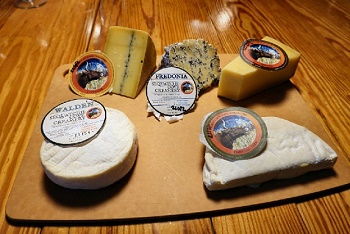
Limburger Cheese: I ran away from the kitchen every time my mother and father ate it! It was a special treat to my parents when my grandfather returned from visiting relatives in the Yorkville area of New York City with bricks of the "smelly stuff", as I called it. In fact I didn't like cheese at all, well, except Velveeta! You should see what I eat now, some that put that Limburger smell of my childhood to shame!
French and Italian cheeses have long been cherished by the people of those lands and thanks to many factors they are available all over the world these days. In fact most American cheese production copies the methods and techniques of European cheese manufacturing. American cheddar is a good example. Cheddar is a town in England where this firm, yet crumbly, sharp, and slightly salty cheese was born and where its name comes from. Cheddar from all across the United States, whether from Vermont, New York or Oklahoma, derive from this. Blue cheese from Denmark is cloned in Iowa as Maytag Blue. Brie from France is produced in Wisconsin. And so the cheese crumbles across our country.
American Dairy Association has granted Good Cooking permission to use its materials in compiling this Internet version of their Cheese Appreciation Guide. You can go to ilovecheese.com for all the information you find here and so much more. As a chef I use cheese in cooking and as a consumer I eat it. I also think of cheese as more than Swiss, Cheddar and Mozzarella. Whatever flavor, perhaps goat cheese, farmstead Camembert or French style Beaumont, I first think of the farmer. I was fortunate to grow up in a very rural area of New York surrounded by dairy farms. In fact my grandfather owned a dairy farm in West Taghkanic NY, farming 250 acres of land for milk production. And I think being a chef is hard work! He sold the farm after part was taken by the state under eminent domain to build the Taconic State Parkway. I still have pictures, know the stories and feel the earth. Now on the land the original farmhouse is built up as a weekend restaurant for well-to-do travelers, and on the remaining land a very expensive multi-million dollar home perched on the highest hill with views of the Hudson River and the Catskills. So goes the "American Farm". There are others from Maine to Oregon and Wisconsin to Florida that have met the same fate or worse---selling the family farm because there is no money left to support it any longer---or even that the sons and daughters didn't want to be in the business and there was no help to hire to run it. How many houses were built on well-tilled farm land, it's impossible to count them, in fact you might even be living in one as you read this! That's why, when I eat cheese, I think of the history and the people who farmed and still farm to bring us this culinary treasure! Hail to the dairy farmers and those who represent them, you all do a great job and Good Cooking wishes you the best.
Here are a few of Good Cooking's favorite American made cheeses.
Coach Farm Goat Cheese, Buttons or Logs, Pine Plains, New York
Maytag Blue Cheese, Maytag Dairy Farms, Newton, Iowa
Provolone, BelGioioso Auricchio Cheese, Inc. Denmark, Wisconsin
White Cheddar, Extra Sharp, Tillamook County Creamery Assoc. Tillamook, Oregon
Fontina, Roth Kase LTD. Monroe, Wisconsin
Camembert, The Old Chatham Sheepherding Company, Old Chatham, New York
Hubbardston Goat's Milk Blue, Westfield Farms, Hubbardston, Massachusetts
Enjoy the Cheese Appreciation Guide and look forward to additional information about American Cheeses. Good Cooking may recommend and or suggest cheeses from the USA for you to try and you as a reader might even suggest cheeses to Good Cooking through our Suggestion Pot. Please feel free to do so, maybe you know of a producer of Cheese Curds or a farm that makes goat's milk camembert, hopefully you will let us know so others can share in the delight.
Recommended Cheese Books
An Excellent Book---Cheese Primer, by Steven Jenkins---Cheeses of the World, Workman Books, NY, NY '96
Wisconsin Milk Marketing Board
California Artisan Cheese Guild
New York State Farmstead & Artisan Cheese Makers Guild
Artisan Cheese Makers of the Northwest
According to legend, cheese was "discovered" 4,000 years ago when an Arabian merchant journeyed across the desert, carrying a supply of milk in a pouch. The lining of the pouch, combined with the heat of the sun, caused the milk to separate into curd and whey. That night he drank the whey and ate the cheese, and thus, so the story goes, our beloved cheese was born.
Cheese is one of the most versatile, delicious foods craved from coast to coast and around the world. And whether you love your cheese melted on a burger, shredded on a taco or perched on a cracker, these pages are sure to teach you something new about your favorite food.
For instance, you don't have to become a
"cheese snob" to enjoy some of the finest cheeses in the world,
because they're made right here in the U.S.A. and available at your local
supermarket. From Cheddar to Brie to Asiago to Havarti, nearly every
variety of cheese imaginable is now domestically produced.
To help you discover the world of domestic cheese, we've categorized
dozens of varieties by their flavor profile - from mild to mellow to
robust. You'll also learn:
Valuable tips on selecting and storing cheese.
The best way to enjoy each cheese in cooking and snacking.
How to create the perfect cheese party tray.
Purchasing Cheese
It's easy to become a cheese connoisseur.
Check out the dairy, deli or specialty cheese departments in your
supermarket and you'll find an extraordinary range of natural domestic
cheese flavors and textures. Use these tips to make
sure you purchase your favorite cheeses in the condition the
cheese makers
intended.
Patronize
retailers with high turnovers of cheese and dated
packaging for product at its peak.
Look for individual cheeses that appear fresh and
appealing.
Choose packaging that is tightly sealed and clean.
Ask to taste a cheese that's new to you.
If you are unhappy with your purchase after you get it
home, always tell your retailer.
More Cheese Please!
For more great ways to enjoy cheese, visit the American Dairy Association.
Thanks to Wisconsin Milk Marketing Board
for providing much of the information in this booklet. Wisconsin produces
more than 350 varieties, types and styles of natural cheese. Taste
Wisconsin Cheese: The Art of the State. Photos courtesy of Wisconsin Milk
Marketing Board.
Storing Cheese
To keep cheeses at their peak once you get them home, they must be stored properly. In general, unopened cheeses stored in the refrigerator between 34 degrees F and 38 degrees F will retain quality even beyond any freshness date stamped on packages. The key lies in keeping them tightly wrapped or sealed to prevent exposure to air and airborne, natural mold spores. Once you open the manufacturer's packaging, follow these guidelines:
Fresh cheeses, such as cottage, cream
and mascarpone, are high in moisture, which makes them more perishable
than firmer cheeses. These cheeses should be kept tightly sealed and
cold and used within two weeks.
Semi-soft, firm and hard cheeses wrapped
tightly and stored in the refrigerator remain fresh for four to eight
weeks. Some aged cheese may be held even longer under proper ' storage
conditions.
Hard cheeses, such as Parmesan and
Asiago, should be stored in grated form in sealed containers in the
refrigerator for up to two weeks. Freeze for longer storage and use
directly out of the freezer.
Ideally only hard-grating cheeses, such
as Parmesan and Romano, should be frozen for up to three months.
Freezing other cheeses, such as Cheddar and Gouda, causes their
texture to become crumbly.
Shredded cheeses lose moisture and
develop mold more easily than solid pieces, because they have more
surface area exposed to air. Wrap leftover shredded cheese tightly and
use within a few days.
Should cheese develop surface mold, cut
off about 1/2-inch from each affected side. The remaining cheese
should be used within the week.
Take special care with aromatic cheeses, such as blue and Limburger. If not tightly wrapped and stored in airtight containers, they can impart their pungent aromas and flavors to other cheeses and foods.
Enjoying Cheese
In addition to appealing taste, variety and texture, cheese offers versatility and convenience. As a snack, an ingredient in a recipe, or a topping, cheese pleases easily every time. These tips will help you serve cheese at its best.
Most cheeses taste best when served at
room temperature. Take cheese out of the refrigerator and let it sit,
covered, for 30 minutes to an hour before serving. However, fresh
cheeses like ricotta, mascarpone and queso blanco should be treated
like fresh milk and can stay out of refrigeration for only brief
periods of time.
Repeated temperature changes hasten deterioration of cheese flavor and texture and the onset of spoilage. For large pieces, cut off only as much as you think you will consume at one sitting, leaving the remainder tightly wrapped in the refrigerator.
Lactose Intolerant? Eat Cheese
If you are lactose intolerant, you can eat
most natural cheeses. This is because, during the process of making
natural cheese, the whey (the liquid portion of milk) is separated from
the curd (the solid components), and most of the remaining lactose is
removed with the whey. The small amount remaining is utilized by the good
bacteria already present in the cheese.
As a result, most ripened cheeses, such as Cheddar and Swiss, contain about 95% less lactose than whole milk. Additionally, aged cheeses, like Parmesan and sharp Cheddar, contain almost no lactose and processed cheeses contain only a slight amount more.
The Cheese Party TrayA beautiful cheese board, carefully balanced in taste, texture and color, makes a delightful and delicious presentation. It can be served as a party platter or as a separate, course at lunch, brunch or dinner. With more than 350 domestic cheeses available, it's easy to create a cheese party tray that is a work of art. Here's how:
Select several cheeses of different
varieties, types and styles, Include contrasting flavors and textures,
for example, Camembert, Gorgonzola, Havarti, Colby and aged Cheddar.
Labeling each type for your guests adds a friendly touch.
For small groups, allow family and
friends to cut directly from a cheese wedge or chunk.
For larger groups, serve cubes, sticks
and squares that have been cut ahead of time.
To complement the cheese, accompany it
with fresh fruit and vegetables, nuts, olives, crackers and oven-baked
breads.
Use already cubed and sliced cheeses to
simplify composition of cheese and deli platters, or follow these easy
directions:
Start with a sharp, clean knife.
Cut cheese while it is still cold.
Cutting can be done early in the day, as long as the cheese is wrapped tightly and returned to the refrigerator.



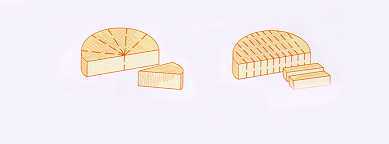
Colby
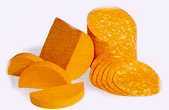
Description: A Wisconsin original. Mild
flavor similar to Cheddar. Firm, open texture with tiny holes. Available
flavored. Best Use: Sandwiches, sauces, casseroles, snacks.
Perfect Pairings: Apples, pears, tomatoes, red wine, beer.
Havarti
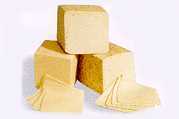
Description: Buttery flavor, smooth, supple
texture. Available flavored.
Best Use: Hot and cold sandwiches, baked potatoes, egg dishes, salads.
Melts easily. Perfect Pairings: Plums, grapes, almonds, rye bread, light
red or fruity white wines, iced tea.
Mild Cheddar

Description: Rich, nutty, creamy flavor; smooth, firm texture. Usually wrapped in clear wax. Best Use. Party trays, sandwiches, burgers, pasta, sauces, egg dishes. Perfect Pairings: Apples, grapes, water crackers, fruity white or light red wines, apple cider, beer.
Fontina
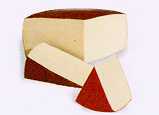
Description: Danish-and Swedish-style:
slightly tart, nutty, mild earthy. Smooth, supple texture with tiny holes.
Best Use. Sandwiches, snacks; baked or cooked dishes.
Perfect Pairings: Plums, grapes, water crackers, cashews, light red or
fruity white wines, bock beer.
Mascarpone

Description: Rich, buttery, slightly sweet
flavor. Smooth, thick, creamy texture.
Best Use. Fillings, toppings, dips, spreads, sauces.
Perfect Pairings: Raspberries, ladyfingers, chocolate, sparkling water,
sparkling or fruity wines.
Monterey Jack

Description: A California original.
Delicate, buttery flavor. Smooth, open texture. Available marbled or
flavored.
Best Use. Hot or cold sandwiches, burgers, salads, Mexican-style dishes.
Melts easily.
Perfect Pairings: Fresh fruit, salsa, fruity wines, beer.
Ricotta

Description: Mild, slightly sweet flavor.
Creamy, granular texture. Best Use: Fillings, stuffings, spreads,
cheesecake.
Perfect Pairings: Sweet berries, croissants, muffins, milk.
Fresh Mozzarella

Description: Delicate, milky
flavor. Soft, slightly elastic texture. I Submerged in water to keep
fresh. Best Use: Salads, sandwiches, appetizers, pizza.
Perfect Pairings: Tomatoes, cured meats, light red wines.
Queso Blanco

Description: Mild, fresh flavor. Crumbly
texture holds shape when heated; does not melt. Best Use. Soups, salad,
polenta, stuffing, snacks.
Perfect Pairings: Mexican-style dishes.
Swiss

Description: Buttery, nutty, mellow flavor.
Firm texture. Dime-size holes, called "eyes." Baby Swiss is
slightly sweet. Available plain and smoked. Best Use: Sandwiches, egg
dishes, breads, vegetables. Melts easily.
Perfect Pairings: Grapes, pears, pumpernickel bread, fruity white or light
red wines.
Medium Cheddar

Description: More piquant flavor and
granular texture than mild Cheddar. Usually wrapped in red wax.
Best Use: Party trays, sandwiches, burgers, pasta, sauces, egg dishes.
Perfect Pairings: Apples, grapes, water crackers, fruity white or
light red wines, beer.
Brie/Camembert
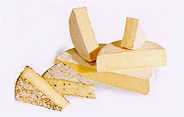
Description: Rich, earthy mushroom flavor
changes from mild to pungent with age. Soft, creamy interior with snowy
white, edible rind.
Best Use. Party trays, sandwiches, snacks. Wrap and bake in pastry. Remove
rind for soups, sauces. Perfect Pairings: Melons, strawberries, nuts,
crusty breads, white or sparkling wines.
Muenster

Description: Edible orange rind with white
interior, creamy texture. Mild flavor mellows with age.
Best Use: Hot or cold sandwiches, salads, Mexican-style dishes, snacks.
Melts easily. Perfect Pairings: Grapes, pickles, sausage, wheat crackers,
fruity wines, beer.
Brick

Description: A Wisconsin original. Mild,
sweet and nutty when young, tangy when aged. Smooth, open texture.
Best Use: Sandwiches, casseroles. Melts easily.
Perfect Pairings: Apples, pears, dark bread.
Gouda/Edam

Description: Gouda (whole milk) has a rich,
buttery, slightly sweet flavor and smooth, creamy texture. Available plain
or smoked. Edam (part-skim milk) has a nuttier flavor and firmer texture.
Best Use., Sandwiches, snacks, salads, soups.
Perfect Pairings: Peaches, pears, dark breads, fruity wines.
Asiago
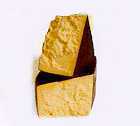
Description: Buttery/nutty flavor (like a
blend of aged Cheddar and Parmesan) becomes more intense with age.
Best Use. Serve as a table cheese for pasta, rice, potatoes, salads,
vegetables.
Perfect Pairings: Grapes, figs, red wines, ales, espresso.
Feta

Description: Packed in brine. Tart, salty
flavor. Available plain and flavored.
Best Use. Greek dishes, salads, hot and cold pasta, egg dishes. Perfect
Pairings: Olives, vegetables, seafood, chicken.
Blue

Description: Ivory color marbled with
blue-gray veins. Piquant, full, earthy flavor. Firm, crumbly texture.
Best Use. Vegetable, fruit and pasta salads, grilled meats, spreads,
dressings, dips. Perfect Pairings: Crusty breads, apples, hearty red
wines, cappuccino.
Gorgonzola
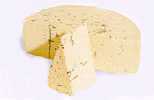
Description: Italian-style Blue -d cheese.
Sharp flavor with slight earthiness. Firm, crumbly texture with greenish
blue mold in veins and pockets.
Best Use: Salads, pasta, ground meat; souffles, spreads, dressings, dips.
Perfect Pairings: Pears, apples, walnuts, heavier red wines.
Gruyere
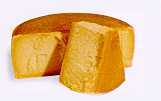
Description: Nutty, rich, full-bodied
flavor. Firm texture with a few tiny eyes.
Best Use: Fondue, baked dishes, onion soup.
Perfect Pairings: Hearty breads, vegetables, apples, chicken, fruity white
wines.
Parmesan

Description: Buttery, sweet, nutty flavor
intensifies with age. Granular texture hardens with age. Best Use: Salads,
cooked dishes, casseroles, pizza; serve as a table cheese.
Perfect Pairings: Grapes, figs, walnuts, bread sticks, red wines, coffee.
Provolone
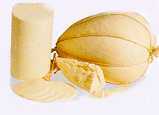
Description: Slightly piquant flavor
becomes sharp and pungent with age. Firm, smooth body I becomes more
granular with age. Best Use. Sandwiches, pizza,
fillings, salads. Melts easily. 1 Perfect Pairings: Pears, grapes,
figs, olives, bread sticks, red wines, espresso.
Romano
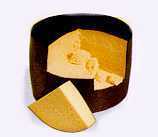
Description: Sharp, piquant flavor.
Granular texture hardens with age. Available as Pepato, which has black
peppercorns.
Best Use: Pasta, soup, salads, pizza, ' egg dishes, stuffing, pastry.
Perfect Pairings: Melons, olives, crusty bread, hearty red
Sharp Cheddar
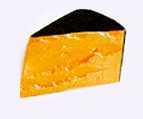
Description: Age gives Cheddar a complex, pleasingly sharp flavor and hard, granular texture. Usually wrapped in black wax. it Best Use: Party trays, sandwiches, burgers, pasta, sauces, egg dishes. Perfect Pairings: Apples, grapes, water crackers, hearty red wines, beer.
Thanks to The American Dairy Association for allowing Good Cooking to reproduce their Cheese appreciation Guide!